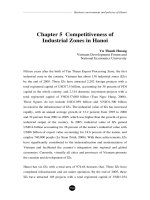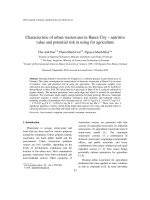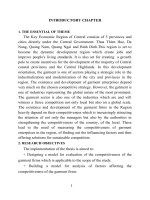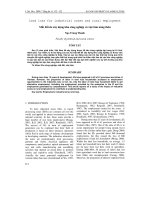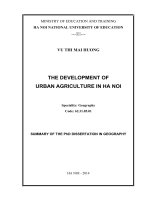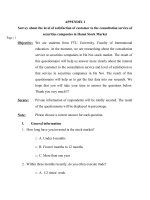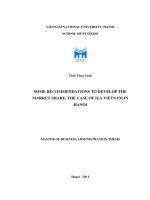Competitiveness of Industrial Zones in Hanoi
Bạn đang xem bản rút gọn của tài liệu. Xem và tải ngay bản đầy đủ của tài liệu tại đây (573.33 KB, 45 trang )
Business environment and policies of Hanoi
Chapter 5 Competitiveness of
Industrial Zones in Hanoi
Vu Thanh Huong
Vietnam Development Forum and
National Economics University
Fifteen years after the birth of Tan Thuan Export Processing Zone, the first
industrial zone in the country, Vietnam has about 130 industrial zones (IZs)
by the end of 2005. These IZs have attracted 2,202 foreign projects with a
total registered capital of USD17.5 billion, accounting for 36 percent of FDI
capital in the whole country, and 2,314 domestic investment projects with a
total registered capital of VND137,000 billion (Tran Ngoc Hung, 2006).
These figures do not include USD1.059 billion and VND31,300 billion
invested in the infrastructure of IZs. The industrial value of IZs has increased
rapidly, with an annual average growth of 33.2 percent from 1995 to 2000
and 32 percent from 2001 to 2005, which was higher than the growth of gross
industrial output of the country. In 2005, industrial value of IZs gained
USD14 billion accounting for 28 percent of the nation’s industrial value with
USD6 billion of export value accounting for 18.6 percent of the nation, and
employ 740,000 people (Le Xuan Trinh, 2006). With these achievements, IZs
have significantly contributed to the industrialization and modernization of
Vietnam and facilitated the country’s integration into regional and global
economies. Currently, virtually all cities and provinces of Vietnam promote
the creation and development of IZs.
Hanoi has six IZs with a total area of 974.64 hectares (ha). Three IZs have
completed infrastructure and are under operation. By the end of 2005, these
IZs have attracted 105 projects with a total registered capital of USD1.254
153
Competitiveness of Industrial Zones in Hanoi
billion plus VND120 billion, and leased out over 400 ha of industrial land.
Additionally, there are 18 industrial clusters (ICs), which are small-sized IZs
under local administration, in the city, of which nine are in operation with a
total area of nearly 90 ha. However, after ten years of development, Hanoi’s
IZs have also encountered limitations in investment environment, planning
and development, location and dimension of IZs, management models of IZs,
and the shortage of land for expansion.
The next section reviews the situation of Hanoi’s IZs and ICs. Section 2
evaluates Hanoi’s IZs in comparison with other locations in Vietnam. Finally,
Section 3 presents some policy suggestions. All information and data are as
of end 2005 unless otherwise noted.
1. Industrial zones and industrial clusters in Hanoi
Industrial zones
There are six IZs in Hanoi licensed under the regulation of IZs, export
processing zones and high-tech parks attached to Decree No 36/CP of the
central government on April 24
th
1997. They are Sai Dong B, Noi Bai, Thang
Long, Ha Noi-Dai Tu, Sai Dong A (Daewoo-Hanel), and the South Thang
Long, which will be described briefly below.
a. Sai Dong B
Sai Dong B IZ was built by domestic capital. Hanel Electricity Company was
the infrastructure developer. It is located in Long Bien District, 10 km from
the city center on Highway No. 5. The total area is 97 ha, of which 79 ha is
available for building the industrial zone. At present, 24 projects operate in
the IZ with the registered capital of USD398 million plus VND121 billion.
154
Business environment and policies of Hanoi
Occupancy is 100 percent. Currently, the IZ is preparing necessary conditions
for opening the remaining area (second phase), which is about 18 ha.
b. Noi Bai
Noi Bai IZ has a total area of 100 ha in the suburb district of Soc Son, 30 km
away from the city center. The infrastructure building company for this IZ is
a joint venture between Renong Co., Ltd. (Malaysia) and Vietnam Industrial
Construction Company. At the end of 1999, the Hanoi People’s Committee
completed Road No.131 connecting Highway No. 2 with the IZ (see map 1).
This improved access to the IZ by cutting 15-20 minutes compared with the
old road. The IZ is located in the priority area for the reduction or exemption
of income tax based on Decree 24/2000/ND-CP of the government on
detailed regulations on Foreign Direct Investment Law in Vietnam. At the
end of 2005, the IZ had 23 investment projects with a total registered capital
of USD122 million. Land for the first phase (50 ha) is all rented out.
Currently, the IZ is implementing procedures for the second phase (50 ha).
c. Thang Long
This IZ is a joint venture between Sumitomo Corporation (Japan) and state-owned
Dong Anh Mechanical Company with a total area of 121 ha. The IZ is
situated in Dong Anh district on the highway to Noi Bai International
Airport, 15 km away from the city center. As of December 31
st
2005, the IZ
had 51 investment projects with a registered capital of USD728.4 million. Its
first phase is fully occupied, and 80 percent of the second phase is also rented
out. At present, the IZ is implementing the third phase and asking for
permission to establish another IZ in Hanoi.
155
Competitiveness of Industrial Zones in Hanoi
Map 1 Industrial zones in Hanoi
Source: The author
156
Business environment and policies of Hanoi
d. Hanoi-Dai Tu
Hanoi-Dai Tu IZ was established by the State Committee of Cooperation and
Investment (now part of MPI) under License No.1385/GP dated August 13,
1995. The infrastructure developer was a 100 percent Taiwan-owned enterprise.
It is in Long Bien District, 10 km away from Hanoi center with a registered
investment of USD 12 million and the area of 40 ha. The original objective of
Hanoi-Dai Tu IZ was to attract investors from Taiwan. At present, only four
Taiwanese enterprises have committed to invest in the IZ. None of them is in
operation. The Hanoi People’s Committee and MPI have proposed a number of
times to the prime minister to cancel the investment license. However, the IZ’s
investor now has signed a contract with Nam Duc Co., Ltd, a local company, to
promote investment and implement projects. According to the IZ’s report, it is
now completing legal procedure and preparing to market the IZ to investors.
e. South Thang Long
This IZ has 119.53 ha, and is located at a favorable site near the city center.
At present, the developer is in the process of completing infrastructure. The
IZ currently has four investment projects, which are under construction, with
an area of 3 ha which accounts for about 10 percent of the first phase.
However, there have been different opinions among the local and central
authorities regarding the objective of this IZ.
f. Sai Dong A
The Sai Dong A Industrial-Urban Zone project was granted Investment License
No.1595/GP on June 17
th
1996. It is a joint venture between Daewoo Corporation
(Korea) and Hanoi Electricity Company (Hanel). The total area is 407 ha, which
is divided into three functional areas: industrial zone (197 ha), residential area
(100 ha), and public park and garden (110 ha). After nine years, the only thing
that the investor had done was to erect a sign, and farm land was left in fallow.
Finally, the Ministry of Planning and Investment (MPI) issued the Decision No
608/QD-BKH dated June 20
th
2006 to terminate the operation of the joint venture
157
Competitiveness of Industrial Zones in Hanoi
in Sai Dong A IZ project. It is possible that the site remained will be changed into
an urban area.
We can see that, among six IZs established by the prime minister, only the
first three are in operation, with land fully or almost occupied and
considering expansion. The next two are in preparation and the last is likely
to be converted into another purpose.
Table 1 Hanoi’s Industrial Zones
Industrial zone Area
(ha)
No. of
projects
Investment
capital
Occupancy
1 Sai Dong B 97.11 24
USD 397.5 million
VND 120.5 billion
100% (1
st
phase)
2 Noi Bai 100.00 23 USD 122.0 million 100% (1
st
phase)
3 Thang Long 198.00 51 USD 728.4 million
100% (1
st
phase)
80% (2
nd
phase)
4 Hanoi-Dai Tu 40.00 4 USD 6.2 million ---
5 South Thang Long 119.53 4 VND 135.0 billion ---
6 Sai Dong A 420.00 0 0 ---
Total 974.64 105
USD 1,254 million
VND 255.5 billion
---
Source: Hanoi IZ and EPZ Management Board (2006)
As Figure 1 shows, by end 2005, the percentage of leased land in Hanoi’s IZs
(40 percent) is lower than many other locations in Vietnam, such as HCMC
(80 percent), Bac Ninh (60 percent), Da Nang (56 percent), Binh Duong (50
percent), and BR-VT (45 percent). This is because three IZs are not in
operation, as noted above. The occupancy ratios of Hanoi’s IZs already in
operation with completed infrastructure are very high. However, Hanoi’s IZs
are often smaller than those in other cities and provinces, especially in the
South.
158
Business environment and policies of Hanoi
Figure 1 Land for IZs in selected provinces in Vietnam
0
500
1000
1500
2000
2500
3000
3500
BR-VT HCMC Binh
Duong
Da Nang Bac
Ninh
Hanoi Hai
Duong
Hung
Yen
Thai
Binh
Hai
Phong
Unleased
Leased
ha
Source: VDF survey, 2005
With 105 projects and USD1.254 billion invested, the IZs in Hanoi account
for about 40 percent of projects and about 60 percent of registered capital of
FDI in the Northern Key Economic Zone (Hanoi, Hai Phong, Quang Ninh,
Hung Yen, Hai Duong, Vinh Phuc, Bac Ninh and Ha Tay). The ratio of
implemented capital to registered capital is over 50 percent in Hanoi. In
2005, enterprises in Hanoi’s three operating IZs created a revenue of
USD1,203 million, of which export turnover was USD834 million. Their
contribution to the state budget was USD5.5 million, with more than 27,000
jobs created. While Hanoi’s IZs account for only 14.8 percent of project
number and 13.5 percent of registered capital in the FDI sector of Hanoi, they
produce 43 percent of turnover, 88 percent of export revenue, and 35 percent
of jobs (Hanoi IZ and EPZ Management Board, 2005). The export revenue
growth of enterprises in Hanoi’s IZs was 64 percent in the period 2001-2005,
higher than the growth rate of Hanoi in general. The average investment
capital of enterprises in Hanoi’s IZs was USD 9.7 million, again much higher
than the average of the country. These numbers show the importance of
enterprises operating in Hanoi’s IZs.
Many foreign manufacturing firms have invested in Hanoi’s IZs in large
scale with high technology. Two of eleven enterprises granted the certificate
159
Competitiveness of Industrial Zones in Hanoi
of a high-tech enterprise by the Ministry of Science and Technology are in
Hanoi’s IZs. They are Orion Hanel (Sai Dong B IZ) and Canon Vietnam
(Thang Long IZ). Total investment capital of the two enterprises is nearly
USD400 million.
Industrial clusters
While IZs are licensed by the prime minister ICs are licensed by the People’s
Committees at the provincial or district level, or even to be set up
spontaneously. Their operation and management are not under Decree 36/CP or
any common regulatory or legal framework. Some provinces have master plans
for ICs while others do not. IZs are generally larger, with an average area of
187 ha, and marked clearly by surrounding walls. ICs are smaller at 100 ha or
less and surrounding walls are optional. IZs are managed by the provincial IZ
and EPZ Management Board and operated by infrastructure developers, which
are either independent companies or administrative unit, and are equipped with
full infrastructure including roads, electricity, water supply, greenery, and a
waste treatment system. ICs are managed by either provincial IZ and EPZ
Management Board or Department of Planning and Investment or Department
of Industry or district’s People Committee and operated by either infrastructure
developers or no one, and have no particular requirement on infrastructure.
The prime minister, on October 15
th
1998, agreed to let Hanoi establish two
pilot ICs, Phu Thi and Vinh Tuy, in order to move manufacturing factories
out of the urban area to the suburbs, and permitted the Hanoi People’s
Committee to approve investment projects. By the end of 2005, eighteen ICs
had been established in Hanoi, of which nine are in operation (including the
second phase of Phu Thi) with a total constructed area of 176 ha and a total
leased area of 90 ha. All of the eighteen ICs are expected to be in operation
by 2008. By 2005, 177 enterprises invested in Hanoi’s ICs with a total
registered capital of VND3,256 billion. According to Hanoi’s IZ
Management Board, main sectors of enterprises entering ICs are electronics
and electrical machines, informatics, textile and garment, leather and
footwear, and mechanics, with an average investment capital of VND5 to 6
billion per project. Enterprises in ICs employed 5,400 workers. In 2005, the
160
Business environment and policies of Hanoi
turnover of enterprises in Hanoi’s ICs was about VND1,202 billion. They
contributed VND52 billion to the state budget (Hanoi IZ and EPZ
Management Board, 2006).
Table 2 Hanoi’s ICs in operation with completed infrastructure,
as of Dec. 31, 2005
No. Industrial clusters Constructed
area (ha)
No. of
projects
Rented
area (ha)
Registered
capital
(VND billion)
Occupancy
1 Vinh Tuy 12.12 18 8.26 114.65 100%
2 Phu Thi 14.80 19 10.42 142.60 100%
3 Tu Liem 21.13 32 13.25 401.46 100%
4 Cau Giay 8.29 22 4.02 948.42 100%
5
Dong Anh
(1
st
phase)
18.00 9 11.03 238.80 100%
6 Hai Ba Trung 9.03 33 4.00 260.00 100%
7
Ngoc Hoi
(1
st
phase)
56.00 28 29.28 987.78 100%
8 Hapro Foodstuff 31.18 5 5.56 57.10 29%
9 Phu Thi (2
nd
phase) 5.40 11 4.14 105.27 100%
Total
175.95 177 89.98 3,256.08 --
Source: Hanoi IZ and EPZs Management Board (2006)
Each of Hanoi’s ICs has a constructed area of approximately 5 to 50 ha. The
Chairman of the Hanoi People’s Committee has the authority to establish ICs,
which are managed by Hanoi’s Department of Planning and Investment
(DPI), Hanoi IZ and EPZs Management Board, and other related
departments. The operation of ICs is also under the control of related
district’s IC Management Boards. In this way, enterprises in ICs are
supervised by many departments at both city and district levels. This is quite
opposite to the spirit of the “one door” mechanism of state administration
over enterprises in IZs under Decree No 36/CP.
161
Competitiveness of Industrial Zones in Hanoi
Owners of infrastructure investment in Hanoi’s ICs are diverse and can be
classified into four types.
• ICs under the control of the IC Management Board of the district,
established by the Hanoi People’s Committee, where the IC is
located.
• ICs invested by the district’s Project Management Unit (PMU) that
builds physical structure both inside and outside ICs. The Board also
manages the operation of the IC.
• The Hanoi People’s Committee assigning land to the district’s
Project Management Unit. This Unit bears responsibility for
completing infrastructure outside the IC; infrastructure in the IC is
built by infrastructure development enterprises.
• If a state-owned enterprise is permitted to transfer the purpose of
land use right to industrial use, that enterprise can be granted the
right to mobilize capital from companies that rent the land and the
state’s budget to build infrastructure for the IC.
However, the first and second types have encountered the problem of not
being able to provide services for enterprises and workers because the owners
are administrative units. Besides this, cooperation between the administrative
owners of ICs and customers (enterprises) is generally poor.
Some problems in IZs and ICs in Hanoi
Development of IZs and ICs in Hanoi has also brought some negative
consequences.
First, free migration into the city is stimulated, which affects security and
social control. Currently, there are more than 32,000 workers in Hanoi’s IZs
and ICs. Most of them come from surrounding provinces such as Hai Duong,
Thai Binh and Nam Dinh, as well as provinces in the Central region. They
come to Hanoi by themselves or through private employment agencies which
are established spontaneously. They lease houses from the local people. Most
162
Business environment and policies of Hanoi
workers have low education levels and some even commit crimes. Mass
immigration also leads to unexpected overloading of social services such as
schools, hospitals and traffic systems, especially in the localities where
workers and their families live and work.
Second, rapid development of IZs and ICs may also create environmental
pollution. Due to the shortage of investment capital and the cutback on
investing in pollution control, investors often cause serious environmental
damage. Some infrastructure developers of IZs and ICs ignore environmental
requirements. Among Hanoi’s IZs, only Thang Long has its own sewage
treatment system. Among ICs, the situation is worse, and sewage disposal
and waste treatment remain unimplemented. Many ICs are located in
crowded residential areas, causing serious effects on surroundings.
Besides these issues, the management and operation of IZs and ICs also show
other weaknesses. For example:
• Master plans for IZs in Hanoi are poorly linked with those in
surrounding provinces. This causes excessive and unnecessary
competition in attracting investment.
• Land clearance is very slow.
• Infrastructure for IZs is often incomplete, and infrastructure for ICs
is very poor.
• Shortages in industrial land are foreseeable, which may curb further
development of IZs. IZs and ICs in operation are already full.
Demand for industrial land is very high while natural land is limited.
• Construction of IZs is very slow due to the limited capacity of
project management boards. Cooperation with the local authority is
inadequate. Supporting mechanisms and policies of the city are not
concrete enough.
• Approval, supervision and implementation of investment projects in
IZs are slow and inadequate.
163
Competitiveness of Industrial Zones in Hanoi
• Control over the construction process of ICs is also inappropriate,
with some enterprises constructing factories using designs totally
different from those approved.
2. Attractiveness of Hanoi’s industrial zones in
comparison with other locations
This section assesses the attractiveness of Hanoi’s IZs from the viewpoint of
investors choosing IZs in which to invest. Evaluation criteria, summarized in
Figure 2, are in line with those in the “Regional Investment Attractiveness
Report” of Indonesia funded by USAID and the Asia Foundation in 2005
29
.
VDF conducted a small-scale survey from August to December 2005 in
eleven cities and provinces
30
. Leaders of IZ Management Boards at the
provincial level, IZ developing companies, and companies operating in IZs
were interviewed. They included general directors, deputy directors, and
heads of departments of respective organizations. Questionnaires were sent
out to companies operating in IZs, with questions focusing on the level of
satisfaction and the condition of infrastructure. Answers were indicated by
numbers ranging from 1 (very bad) to 5 (very good). The questionnaire also
included questions on land rent and financial and time costs to access an
international airport and a seaport. The questionnaire was followed up with
in-depth interviews with almost all organizations and companies. The key
results are reported below.
29
The project has conducted annual rating of investment attractiveness among 228
regions and cities of Indonesia since 2001. The survey also mostly based on business
perception.
30
Surveyed cities and provinces are as follows, with numbers in brackets indicating
the numbers of visited IZ management board, IZ developing companies, and
companies operating in IZs, respectively: Hanoi (1,2,8), Hai Phong (1,0,0), Hai
Duong (1,2,3), Bac Ninh (1,0,3), Hung Yen (1,1,3), Thai Binh (1,0,0), Da Nang
(1,1,1), BR-VT (1,1,2), HCMC (1,0,1), Dong Nai (0,0,3), Binh Duong (1,0,3). The
total number of visits was 44.
164
Business environment and policies of Hanoi
Figure 2 Determining Factors of Attractiveness of IZs
External criteria
Internal criteria
Geographical position
Capacity of
supporting industries
Infrastructure
outside IZ
Availability of
trained workers
Labor cost
Quality of services
outside IZ
Choosing IZ
location
Attractiveness
of IZs
Tax and other
incentives of local
government
Attitude of local
officials
Electricity supply
Water supply
Infrastructure
inside IZ
Waste disposal and
sewage treatment
Land rental price
Land renting
For many enterprises, land rent is one of the most important criteria in choosing
investment location, especially with labor-intensive production processes
which always require large space. Land rent in IZs depends on location,
infrastructure services, management and terms of payment. Land rent levels in
Hanoi’s IZs are shown in Table 3.
165
Competitiveness of Industrial Zones in Hanoi
Table 3 Land Rent in Hanoi’s IZs
1. Sai Dong B (40 years remaining)
Lot size
Annual payment
(USD/m
2
/year)
Payment in
every 5 years
(USD/m
2
/year)
Pay full in advance
(USD/m
2
)
1. Under 5,000 m
2
2.6 2.4 55 (1.15 USD/m
2
)
2. 5,000 to 10,000 m
2
2.55 2.2 52 (1.08 USD/m
2
)
3. More than 10,000 m
2
2.2 2.15 48 (1.03 USD/m
2
)
2. Noi Bai ( 39 years remaining)
Pay in two installments (1
st
and 15
th
year) USD 50 for 30 years = 1.66
USD/m
2
/year
Pay once for 45 years 1.33 USD/m
2
/ year
Management fee 1.26 USD/m
2
/ year
Total 2.92 or 2.59 USD/m
2
/ year
3. Thang Long (41 years remaining)
Pay full in advance for 47 years USD 75 for 47 years = 1.60
USD/m
2
/year
Management fee 1.26 USD/m
2
/ year
Total 2.86 USD/m
2
/ year
4. Dai Tu (39 years remaining)
Pay full in advance for 39 years USD 78 for 39 years = 2.0 USD/m
2
/year
5. South Thang Long
Not available
Sources: Hanoi IZ and EPZ Management Board (2003),
and VDF survey for Dai Tu
While the average land rent in Hanoi is 1.5 USD/m
2
/year, there are
differences in rent levels (excluding management fees) among IZs. In
comparison with other cities and provinces, average rent in Hanoi’s IZs is
relatively high (Figure 3). It is ranked second in Vietnam after HCMC (USD
1.85/m
2
/year), and higher than in all other cities and provinces, especially
northern provinces such as Thai Binh where land rent in IZs is only USD
0.13/m
2
/year. Incidentally, some IZs offer rent discount for investors renting
166
Business environment and policies of Hanoi
large space. This practice may be suitable for marketing purposes, but there is
a risk of encouraging enterprises to rent unnecessarily large plots to get a
lower price, which remain unused.
Figure 3 Average Land Rent in Operating IZs
in Selected Cities and Provinces
Unit: USD/m
2
/year
1.00 1.00
0.80
0.40 0.40
0.50
0.50
1.50
1.85
0.13
0.0
0.2
0.4
0.6
0.8
1.0
1.2
1.4
1.6
1.8
2.0
HCMC Hanoi BR-VT Binh
Duong
Hai
Phong
Bac
Ninh
Hung
Yen
Hai
Duong
Da
Nang
Thai
Binh
Source: VDF survey, 2005
Location
It takes 10 minutes to transport goods from Noi Bai IZ to the airport, while
the corresponding figures for Thang Long IZ and Sai Dong B IZ are 20
minutes and 50 minutes, respectively. These are the answers of companies
operating in IZs. In the North, Noi Bai International Airport plays the key
role in air transportation, and many investors who need this service choose to
invest in and around Hanoi to save time. A surprisingly large number of FDI
and domestic firms in IZs use air transportation for exports and imports,
either regularly or occasionally, including those in electronics, informatics,
167
Competitiveness of Industrial Zones in Hanoi
168
textile and garment, and footwear. The general director of Thang Long IZ
remarked that that airway was the most popular mode of transportation
among companies operating in this IZ. As for another example, the leader of
a garment company, 100 percent-invested by Chinese capital, producing suits
and other clothes in Hai Duong province for the US and EU markets, said
that all products were exported by air through Noi Bai International Airport.
It is clear that easy access to an international airport is a great advantage of
Hanoi, HCMC and, to a lesser extent, Da Nang.
From Hanoi, average time for a 20-feet container truck to reach Dinh Vu
Seaport in Hai Phong City (120 km away) is 150 minutes (see map 2). It
takes 270 minutes to reach Cai Lan Seaport in Quang Ninh Province (170 km
away). Obviously, time and distance depend on the exact location of the
factory, time of the day, and road condition. In our survey, investors
operating in IZs reported the following average time and distance to Hai
Phong Seaport: Sai Dong B - 120 minutes/100 km; Thang Long - 150
minutes/120 km; and Noi Bai - 180 minutes/130 km. Regarding access to the
seaport, Hanoi has no particular advantage in comparison with other
provinces along Highway 5 or Highway 18 in the North, or economically
active cities and provinces in the South.
Business environment and policies of Hanoi
153
Source: The author
Map 2 IZs in Hanoi and the Road to Dinh Vu seaport
